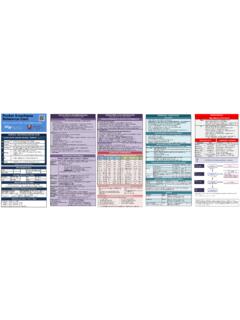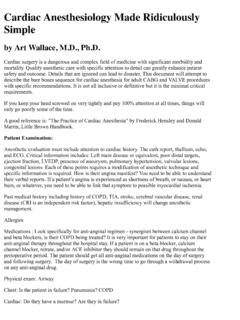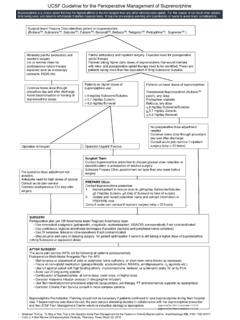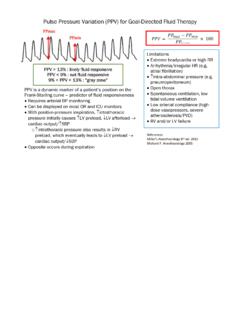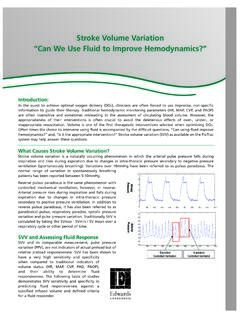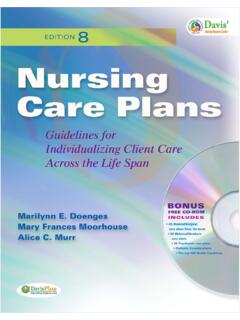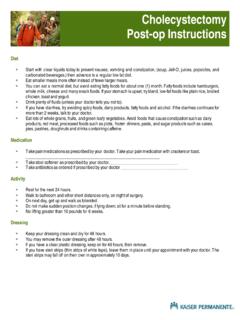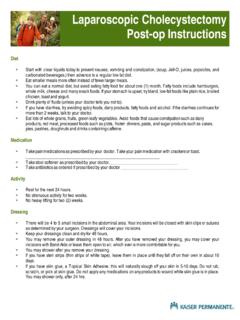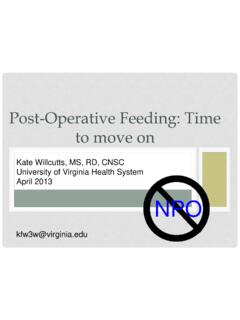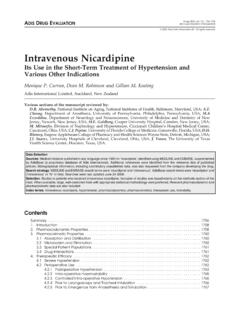Transcription of Lidocaine Infusion for Analgesia
1 Lidocaine Infusion for AnalgesiaMOAD osingPharmacologyReferencesPerioperative UseLocal Anesthetic Systemic Toxicity (LAST) 1. Attenuation of proinflammatory effects: Blocks polymorphonuclear granulocyte priming, reducing release of cytokines & reactive oxygen species12. Diminish nociceptive signaling to central nervous system: Inhibition of G-protein-mediated effects2 Reduces sensitivity & activity of spinal cord neurons (glycine and NMDA receptor mediated)3,43. Reduces ectopic activity of injured afferent nerves5 IV local anesthetic infusions have been used safely for pain control in the perioperative setting since the early 1950 s6,7 Reduce pain, nausea , ileus duration, opioid requirement, and length of hospital stayEvidence for Specific Surgeries:9-12 Strong: Open & laparoscopic abdominal.
2 Reduces postoperative pain, speeds return of bowel function, reduces PONV, reduces length of hospital stay Moderate: Open prostatectomy, thoracic procedures, ambulatory surgery, and major spine; Reduces postoperative pain and opioid consumption Moderate: Breast; Prevention of chronic postsurgical pain No benefit: Total abdominal hysterectomy, total hip arthroplasty, and laparoscopic renal surgery Hepatic metabolism with high extraction ratio; plasma clearance is 10 ml/kg/min13 Adjust dose based on hepatic function and blood flow Renal clearance of metabolites Context-sensitive half-time after a 3-day Infusion is 20 40 min Clinical effect of Lidocaine tends to exceed the duration of the Infusion by times the half-life, supporting the putative preventive Analgesia effect14 Infusion .
3 2mg/kg/hr(range mg/kg/hr)Loading (range 1-2 mg/kg) Strongly consider bolus to rapidly achieve therapeutic concentration, otherwise steady state reached in 4-8 hrMax dose: mg/kg Consider total dose from other local anesthetics ( regional anesthesia, periarticular injections, & local infiltration)Continuous infusions up to 3 mg/kg/hrhave been shown to be safe Reduce Infusion rate in patients with impaired drug metabolism & clearance ( hepatic & renal dysfunction)Therapeutic level: g/ml CNS toxicity: >5 g/ml Cardiovascular toxicity: >10 g/mlCaution Unstable coronary disease, recent MI, heart block, arrhythmias, heart failure Electrolyte disturbances Seizure disorders Liver disease (decreased metabolism) Renal disease (decreased clearance of metabolites) Mild: Paresthesias(fingers, toes, perioral), metallic taste, tinnitus, lightheadedness, dizziness, visual disturbances, confusion Moderate.
4 nausea , vomiting, severe dizziness, decreased hearing tremors, BP/HR changes, confusion Severe: Drowsiness, confusion, loss of consciousness, muscle twitching, seizures, cardiac arrhythmias, cardiac arrestACLS**Reduced epinephrine dose, lipid emulsion (20%), benzodiazepines for seizures, consider K. Dunn. Anesthesiology 2017;126(4) MW. Anesthesiology. 2002;97:1451 Eur J Pharmacol. 2009;613:68 I, Woolf CJ. Pain. 1996;64: , I. Pain 2011; 152:1562 AS. JAMA. 1951;147: CR. Intravenous use of xylocaine.
5 CurrRes AnesthAnalg. 1951;30: , Y, Li. Dis Colon Rectum 2012; 55:1183 , E. Br J Surg 2008; 95:1331 , P. Cochrane Database Syst Rev. 2015; 7: , L. Can J Anaesth2011; 58:22 , GC. Drugs 2010; 70:1149 J AnesthClin Res. 2016;8 , A. AnesthAnalg2013; 116:1141 = (x*10) mg/mLReviews Articles: Lauren K. Dunn, Marcel E. Durieux; Perioperative Use of Intravenous Lidocaine . Anesthesiology 2017;126(4):729-737. N Eipe, S Gupta, J Penning, Intravenous Lidocaine for acute pain: an evidence-based clinical update, BJA Education, Volume 16, Issue 9, September 2016, Pages 292 298.
6 Weibel S, JeltingY, Pace NL, HelfA, Eberhart LHJ, HahnenkampK, Hollmann MW, PoeppingDM, Schnabel A, KrankeP. Continuous intravenous perioperative Lidocaine Infusion for postoperative pain and recovery in adults. Cochrane Database of Systematic Reviews 2018, Issue 6. Art. No.: CD009642.

